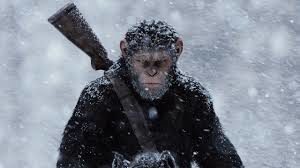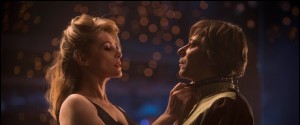Posted: December 20, 2012 | Author: Donald | Filed under: Uncategorized | Tags: Andy Serkis, Barry Humphries, Fran Walsh, Guillermo del Toro, Howard Shore, Ian McKellen, Martin Freeman, Peter Jackson, Philippa Boyens, The Hobbit, The Hobbit: An Unexpected Journey | 22 Comments »
After finishing the two and a half hour The Hobbit: An Unexpected Journey (which is still only one third of a three part movie), I was trying to figure out why the film was holding together as well it was. Was it due to director Peter Jackson’s spectacular and thrilling visuals (backed by a superlative design team)? Was it because of Howard Shore’s part thundering, part wistful music score? Or was it maybe, just maybe due to Martin Freeman’s gift for the double take? By the time it was all over, I wasn’t sure, but I strongly suspect it was the double take gift thing, mainly because whenever Freeman isn’t on screen, the story tends to lag a bit at times, while at other times, it tends to lag a bit more than a bit. But when Freeman is on screen, the movie is pretty much everything you could hope for.
The basic story, for those of you who have just returned from a trip to Alpha Centauri, is a prequel to J.R.R. Tolkein’s magnum opus The Lord of the Rings, which has already been filmed (boy, has it been filmed). This time it’s the story of Bilbo Baggins, a rather well contented hobbit very satisfied with his lot in life, who is convinced by the great wizard Gandalf (Ian McKellen, natch), with all the finesse of a psychiatrist with unlimited payouts from insurance, that he is actually very unhappy with his miserable lot in life and is in serious need of years of therapy. Gandalf’s suggestion: join up with a bunch of dwarves to help them win back their gold that has been stolen by a dragon (in modern politics, if you’re conservative, that would make Gandalf the Koch Brothers, the dwarves Boehner and the Republican Congress, Bilbo the tea party, and the dragon Obama and the 47 percent; if you’re a liberal that would make Gandalf Obama, the dwarves the middle class, Bilbo the democratic congress and the dragon the Koch brothers—with Grover Norquist sticking his head in as Azog every once in awhile; but, hey, the election’s over, so there’s no point in beating a dead orc).
In many ways and for most of the movie’s endurance, this is a pretty nifty film. It’s not perfect by any means and its sins are mainly structural. It tends to stop dead whenever one of two things happen: when the Dwarves start singing as if they’re an earlier incarnation of those damn Von Trapp kids; and whenever there’s a flashback to fill in some plot point or other. In other words, from the moment that the tale is told of Thorin’s battle with Azog until the dwarves sneak off from Rivendell the movie is, well, a bit of a rough going.
The main problem, I suspect (and this is based upon my having read the book forty years ago—yes, forty years, you wanna make something of it?), Jackson, and his co-writers Fran Walsh, Philippa Boyens and Guillermo del Toro, are not just trying to do Tolkein’s The Hobbit, which was a rather light and fun little read. They are trying to tie Bilbo’s story into the larger one by saying that the events of that trilogy of books actually began not just with the discovery of a ring. In Jackson’s The Hobbit, the evil that comes close to destroying Middle Earth can be found in a larger series of events independent of Bilbo and Gollum’s little pax de deux, with tales of a necromancer; orcs and trolls not knowing their place and encroaching on more civilized peoples; and forests dying. (BTW, it just occurred to me—why would anyone call the era Middle Earth if there hasn’t been an era after Middle Earth yet; isn’t that like calling World War One World War One before there was a World War Two? But I digress.).
But once everyone’s on the road again, things really pick up (boy, do they pick up), the story reaching both it’s action and emotional highlights when it gets split between a breathtaking fight in the goblin kingdom (with Barry Humphries reprising his Dame Edna roll as the king, but with a smaller double chin) and the more restrained, more intimate scenes of Bilbo finding the ring and encountering the pathetic, schizophrenic Gollum (a triumph of CGI and Andy Serkis’s amazing performance). One may be over the top (and employ every SFX known to man) and one may be more of a chamber drama (and employ almost every SFX known to man), yet both are equally exhilarating and emotionally gripping, and great credit must be given to both the writers and director here.
The ending of this section of the Tolkein triptych is a bit clunky. And again it’s a structural issue. The Hobbit: An Unexpected Journey brings down the first act curtain with a battle scene that comes too close to an earlier battle scene, which dilutes this second’s climactic fight. Well, at least at first. Once you get past the opening salvos, everything gets smoothed over and the film soars again (both figuratively and literally). And it’s hard not to want to see what comes next.
So, my ultimate opinion? Okay, it’s not perfect. But in the end? I pretty much found the whole thing to be pretty awesome.
 First, a word from our sponsors: I wanted to say thank you to everyone who contributed to our Indiegogo campaign for 15 Conversations in 10 Minutes. We did very well due to you folks. For those who weren’t able to give, keep us in your thoughts. And if you are able to contribute in the future, contact me and I’ll tell you how. I will even honor the perks on the
First, a word from our sponsors: I wanted to say thank you to everyone who contributed to our Indiegogo campaign for 15 Conversations in 10 Minutes. We did very well due to you folks. For those who weren’t able to give, keep us in your thoughts. And if you are able to contribute in the future, contact me and I’ll tell you how. I will even honor the perks on the  I am well aware as to what the critics and my fellow movie goers feel about War for the Planet of the Apes.
I am well aware as to what the critics and my fellow movie goers feel about War for the Planet of the Apes. The new movie, Venus in Fur, co-written by bad boy old timer Roman Polanski (who also directed) with relative new comer David Ives, from a play by Ives that was influenced by a book by Leopold von Sacher-Masoch (yeah, that Sacher-Masoch—oh, no, don’t even try it, you know very well whom I’m talking about, you can’t fool me), begins during a somewhat impressionistic rain storm on a deserted street in France (so I guess the slight touch of impressionism shouldn’t be a surprise) backed by a music score of sublime slyness.
The new movie, Venus in Fur, co-written by bad boy old timer Roman Polanski (who also directed) with relative new comer David Ives, from a play by Ives that was influenced by a book by Leopold von Sacher-Masoch (yeah, that Sacher-Masoch—oh, no, don’t even try it, you know very well whom I’m talking about, you can’t fool me), begins during a somewhat impressionistic rain storm on a deserted street in France (so I guess the slight touch of impressionism shouldn’t be a surprise) backed by a music score of sublime slyness.